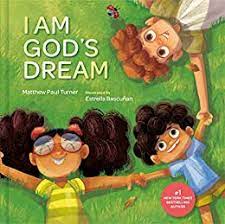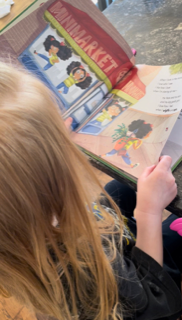The thesis of I Am God’s Dream is beautifully articulated about halfway through the book. It says, “When I look in the mirror, I think of what’s true: that God loves me and wants me to love myself too.”
Isn’t that just exactly what we want for our kids? What an important message right now!
This post contains referral links for these products. As an Amazon Associate I earn from qualifying purchases. It does not cost you extra to purchase through my links.
I was provided a copy of I Am God’s Dream to review. However, this review is not paid for, and all thoughts are my own. (As you will see…)

My overall thoughts on this faith-filled picture book
I Am God’s Dream is a rhyming, inspirational Christian picture book, new in April 2022.
The message of the book is that God made the reader just wonderful, and the reader is so loved by God and by their family. It is a wonderful message
Theology of I Am God’s Dream
There are no scripture references or verses quoted in the text of the book. However, it is clearly stated that God created us, and loves us in our uniqueness.
One of the lines I liked the most is, “Loved just as I am, I’m a star in God’s sight.
How true is that! Listen, I know we’re all fallen, and we all need to do better, but we are still loved. Even if we mess up horribly every day for as long as we live. That is the message of this book. Of course I love books that remind my kids that they NEED Jesus, and this one is not that. At all. But I also want their heart to leap with the knowledge that they are truly loved for them.
Some parts of the book are less applicable to all children. For example, when the author talks about unruly hair. Or that the child is hardly ever neat. Obviously, that won’t apply to all children. However, it serves the important purpose of letting our kids know that they don’t have to be perfect or fit a mold to be loved.
There is a theme throughout that God never stops dreaming. I took this to mean that God has plans or “dreams” for all of us. Therefore, using the word “dreaming” as an extra-Biblical personification of God didn’t bother me, because I do fully believe he has plans for us! If you’re against personifying God in this way, that may weird you out a bit, so FYI.
There had been whispers on social media about the use of the word “transcend” in the book. You know, because it has sort of a hippy/not traditional/ehh connotation. The full line in the book has the child narrator planning “…to love what God loves, to heal and transcend.”
However, since transcend means to move up or move beyond, I took this line as saying that the narrator will continue to grow and learn, and keep getting better. Therefore, the use of “transcend” didn’t bother me at all.
Literary Merit
I hate to be that person. But I am going to be that person. It’s the internet, what’s the worst that can happen?
This is not Turner’s best work from a literary/writing perspective. (I reserve that honor for When God Made You, which I’ve reviewed before.)
In I Am God’s Dream there are some clunky rhymes, especially on the final three pages.
There is also a recurring break from the target audience. When reading a picture book written in the first person perspective of a child, if the narrator says, “you,” it should be directed towards the child listening to the book. Therefore, it shouldn’t be negative, or make it seem like the listener is the “enemy.” That doesn’t make any sense. Unfortunately, Turner breaks that rule a few times.
For example, the book says, “You might be surprised what God knows I can do!”
Who is this “you” you speak of? The little listener? I think not, the entire point of the book is to have the listener see themselves like the narrator does.
Unfortunately, this picture book faux pas happens several times in the text.
There are some wonderful lyrical moments, and overall I think it’s an excellent book. However, I worry it could have used a sharp editing eye to get it to the level of picture book awesomeness that readers have come to expect from Turner. The message is great, but I’d like the message to be in a perfect, stunning package of prose, and unfortunately, that doesn’t always happen in this book.
Illustrations
The illustrations are so darling. They are colorful, there is a beautiful urban garden theme throughout, and kids of all types represented! So well done.

The main character is a girl, but as a mom of both boys and girls, I appreciated that both were shown in the illustrations.
So lovely!!
Age Range
The publisher recommends I Am God’s Dream for ages 3 through 7. I heartily agree, and think you could definitely expand that. With rhyming prose (and not a ton of it on a page) you could start reading it at any age. My 2 year old liked it.
I also think you could push the age up. Who doesn’t need to be told that God loves them and wants them to love themselves? Let’s face it, I could use that message, and I’m way way WAY older than 7.
If you’re thinking of giving it as a gift, or reading it to younger kids, or using it for Sunday school or something like that, I’d pair it with the board book You Are: Speaking God’s Word Over Your Children by Emily Assell. It is a similar vibe, affirming our children, with scripture to read.
Overall Thoughts
I recommend I Am God’s Dream. As my kids grow up and away from us, I know they won’t remember me reading this book to them. But I hope they remember its message: they are loved, just as they are.
More theology reviews of picture books
If this type of picky Christian mom review is your jam, make sure to check out my other theology deep dives into new picture books:
The theology of work in The Creator in You
The theology of creeds in The Apostle’s Creed: For All God’s Children


